Guest Post: Najia Bagi
14th October 2019The Momentless Existence
My dad is Arabic; he is from Benghazi in Eastern Libya. He came to Europe as a young art student, studying in Rome and then travelling to the UK to study for a Master’s Degree in English literature where he met my English mum. Together they had three children, my two younger sisters and me.
The introduction I have just given is one I have rehearsed all my life. It is a justification of why my dad is here and therefore, why I am here. It is a composed presentation of the past because it is a list of his achievements and importantly, his movement towards Westernisation. It is also a story that makes his being Arabic, more real to me.
I have realised as I have grown older, that my story, or fiction, of my father’s rightful place in the UK is a reflection of his own fragmented memories of home and his journey of cultural heritage and identity. These fictions have been passed down to my sisters and me, and again from me to my daughter. Along with pride and joy, nostalgia and longing, one of the overwhelming feelings created by these stories is one of absence.
According to Frankowski, the white gaze creates a “momentless” reflection of existence of diasporic cultures because it is created from “violent” moments of history, which means that those held under the white gaze are left in some way “without time”. Although not violent, the spoken and sung stories of my father’s homeland which I experienced as a child, created “a past invented for the present”, relaying a beautiful, nostalgic and absence-filled image of his and therefore my, cultural identity. It is this re-creation that I have always felt so sorely distanced from, and these are the borders I want to write about here.
Through my recent research I have been asking how dialogue, performance and embodied studio practice can address these borders through self understanding and by creating a series of present moments, combatting the momentlessness that Frankowski wrote about.
Creating Present Moments
In 2018 I began to work with recordings of my dad speaking in Arabic, improvising to the recordings and making new looped and layered sounds from them. It was a way for me to understand his past and also begin to foster a feeling of belonging to the stories he told, through working in the present moment.
Finding these present moments, through deep listening, dialogue and embodied practices, is something that I began to research through my recent Masters at Goldsmiths College, and which I believe provides a way for children of immigrants or exhilants, to find a connection with our identity. When I was mindfully practicing whilst listening to the stories my father told, it didn’t matter that I have never visited North Africa or that I don’t wear the hijab. All that mattered was that I was listening.
The next phase of my research was recording my sisters talking about their experiences of having an Arabic father, which I did because I had an urge to connect my experience with theirs, to find commonality and understanding. During our conversations there was an overwhelming feeling of my sisters feeling that their identities weren’t valid , and that they didn’t feel they had permission to own their cultural heritage. The story didn’t seem to be theirs to tell; it belonged to the past or to the people in their lives who told them that they didn’t look Arabic, or to the doubts that they had in their own minds about not being able to speak the language or cook the food authentically, for example. This is an excerpt from the recording where one of my sisters is talking about her identity as a non-white British woman:
“I feel like… I feel like… I’m not valid enough… I’m not valid to make… I think that’s the thing with me.” (5:48).
I created further dialogue with these recordings by practicing embodied piano technique whilst listening to the interviews. This deep listening was, for me, an opportunity to create space for our stories. By listening, and responding in the moment with my body and a musical instrument, I was using dialogue as a creative process. And for something as personal and sensitive as cultural identity, this seemed a sensitive and relevant way of treating the material. Listen here
During the work I did with my sisters, it struck me that each of our experiences were so different from one another’s but that we each chose to find meaning in our present lives for abstract concepts such as cultural heritage. For example, one of my sisters equated making food with her cultural heritage and my other sister talked about physicality as a way she felt distanced from our Arabic heritage (she felt she didn’t “look Arabic”). These themes repeated over and again in the recordings and affected repeated movements in my embodied piano practice whilst I was listening.
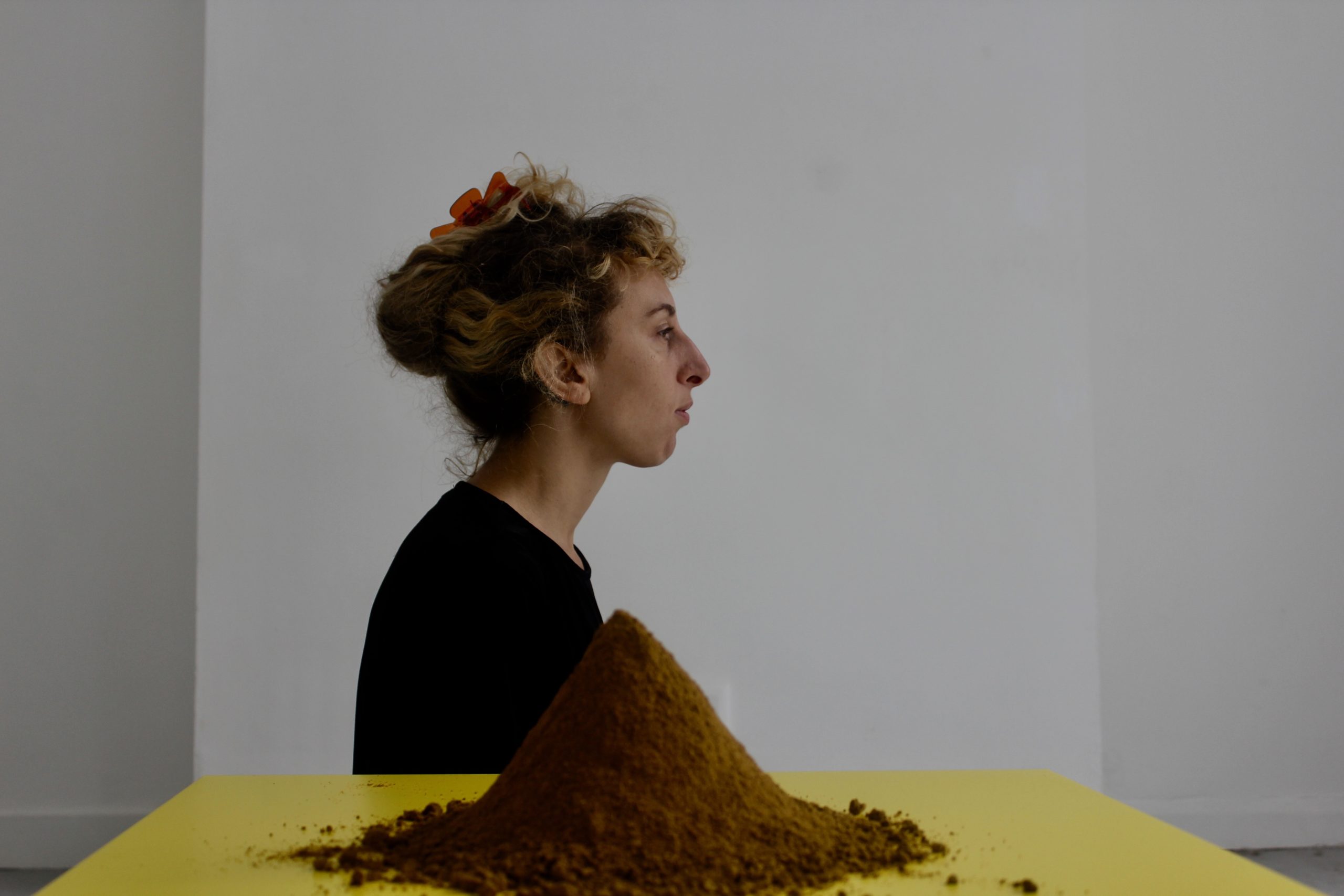
Najia Bagi in her Dialogues exhibition. Installation shot, Piano Work to a Family Conversation (audio), spice, plinth and light. London, 2018. Photo credit: Genevieve Dawson
Curating Embodied Practice
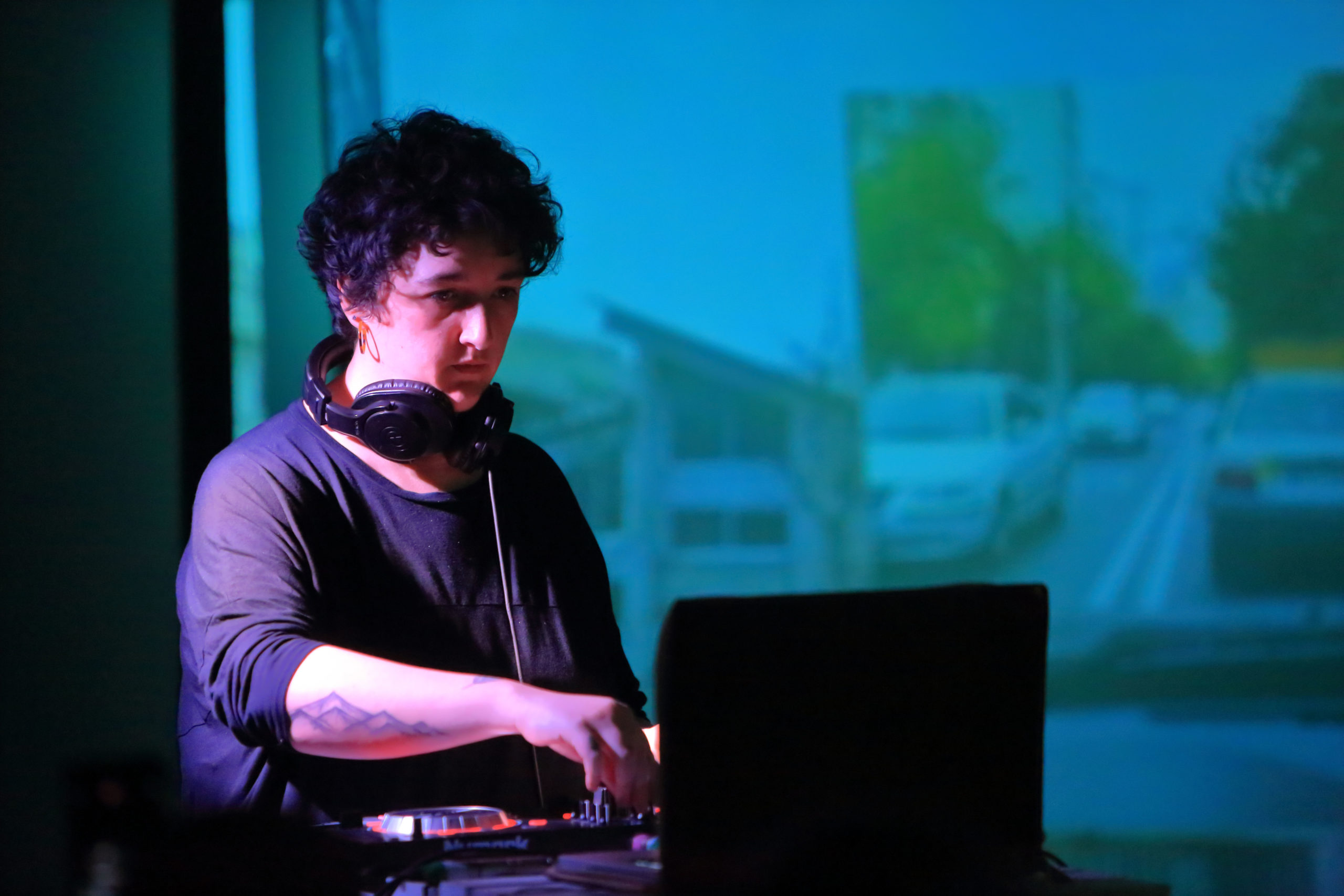
Zahra Haji Fath Ali Tehrani, performance. Modern Art Oxford, April 2019. Photo credit: Stu Allsop
Whilst developing my own practice, I became fascinated by other artists who were also exploring their cultural heritage. I was particularly interested in female artists who use their physical presence to perform their perspectives, using the present moment to connect to the past. This fascination eventually led to my programming Between Anywhere and Nowhere at Modern Art Oxford, creating a space where I invited three special artists, Umama Hamido, Jumana Hokan and Zahra Haji Fath Ali Tehrani, to perform perspectives of their connections to Middle East cultural heritage in the company of one another.
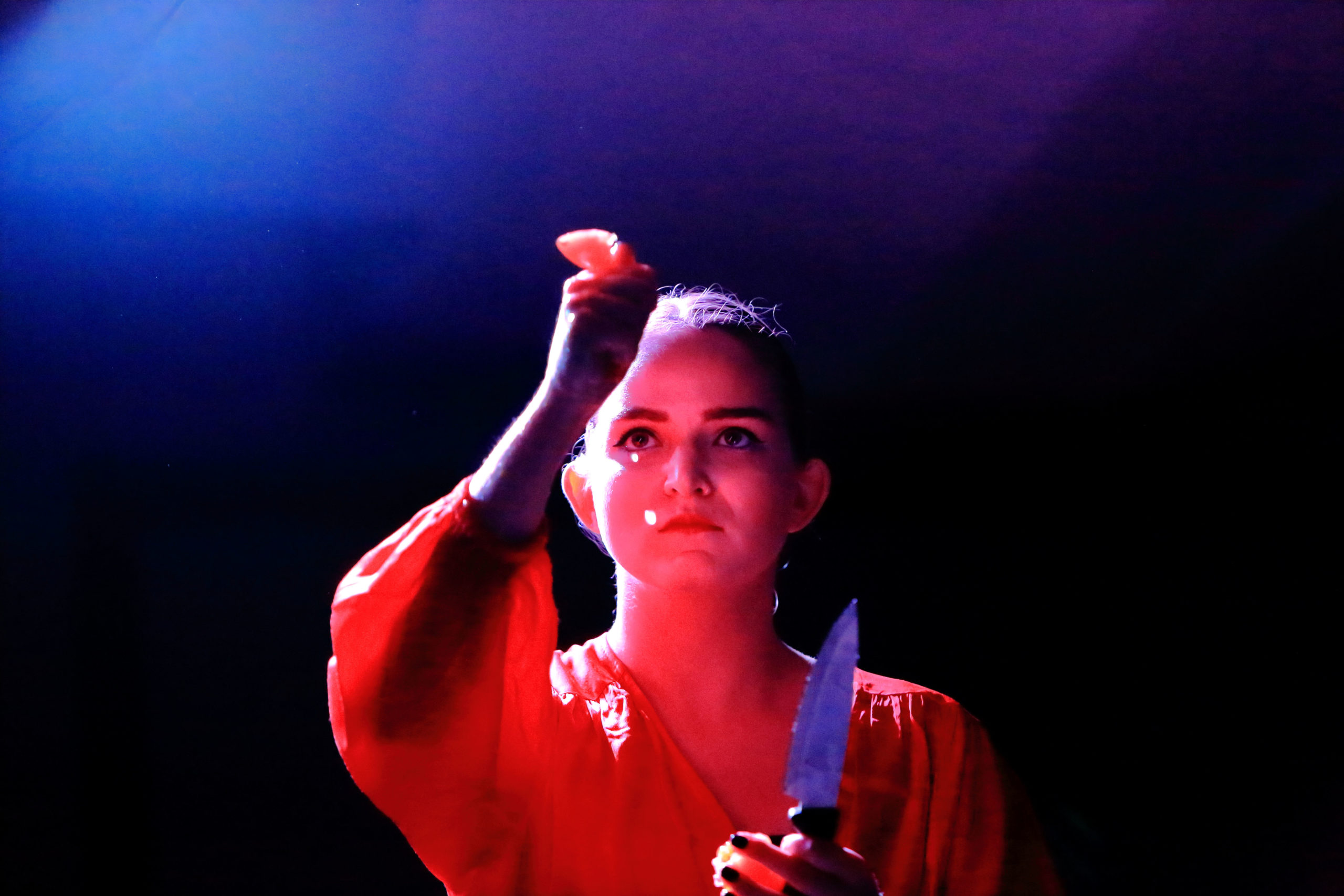
Jumana Hokan, Laima’s Fruit, performance. Modern Art Oxford, April 2019. Photo credit: Stu Allsop
The title for the event came from one of the artists, Umama Hamido’s, biography, which states that the artist lives “on the border between many places and nowhere”. This really resonated with the concept that place and time are warped by our lived connections to and distance from, our cultural identity. The evening included cinematic performance by Umama, live interactive performance by Jumana and an experimental DJ set by Zahra.
Each one of these women held beautiful space for the exploration and sharing of their cultural heritage, and the collective presentation of all three performances taught me and the audience something new about how we view and understand one another, and how we can use our bodies to connect with our own lives and past experiences.
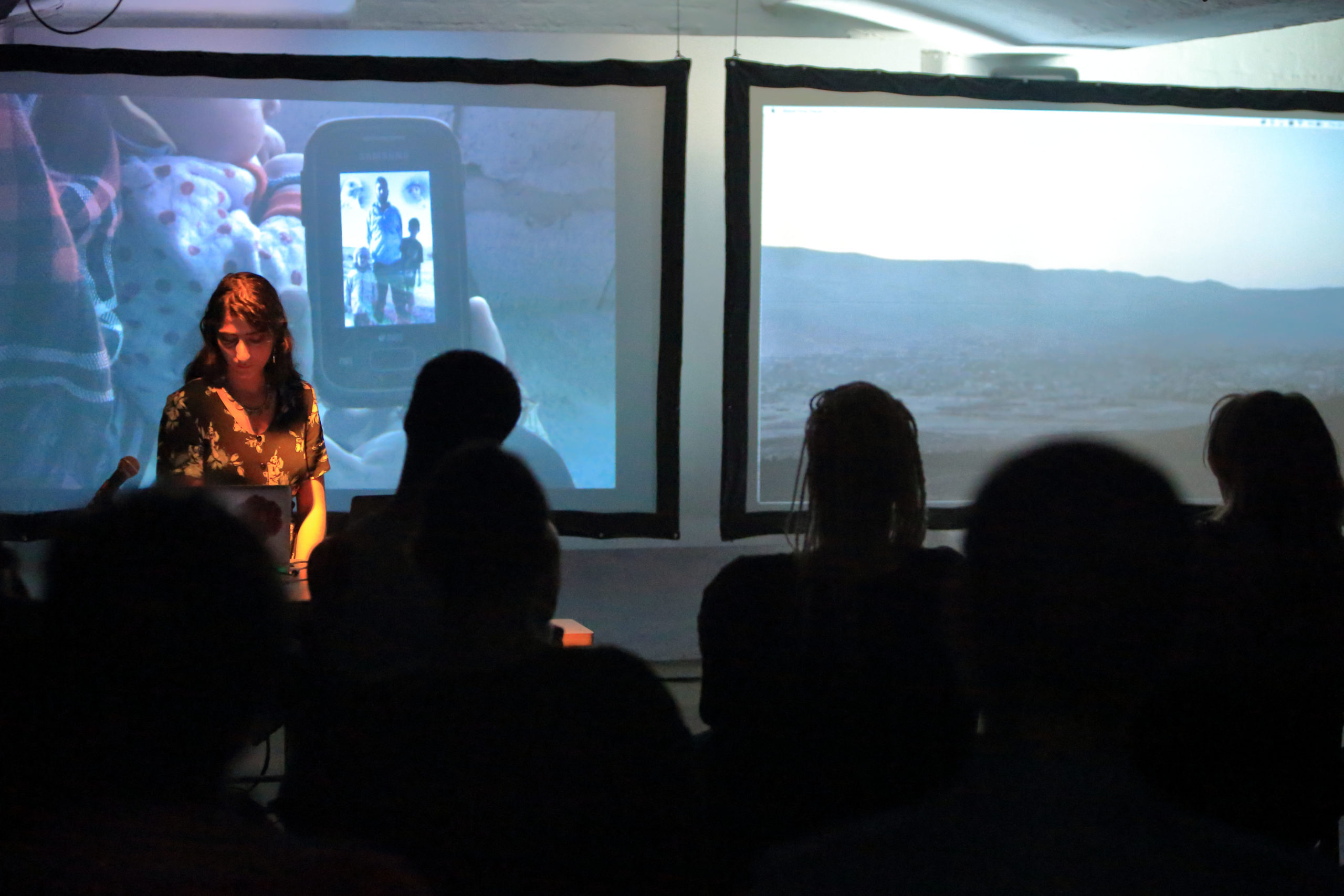
Umama Hamido: HIND, performance, Modern Art Oxford April 2019. Photo credit: Stu Allsop
Umama, Jumana and Zahra
I continued my research by asking Jumana, Umama and Zahra to reflect on the experience of being asked to perform at Modern Art Oxford in writing. I also asked each artist to share a song which expressed the relationship they have with their cultural heritage. The following words and songs belong to them:
Umama Hamido:
I Missed You When You Were Here by Om Khaltoum: Listen here
Zahra Tehrani:
Kharabati by Hayideh: Listen here
The event in April was a massive deal for me; I’d lived in Oxford my whole life and never been invited to make anything based on my heritage. Understanding identity is a huge journey and a milestone for me was that event, because I was given the opportunity to explore my background through music in a more experimental way than usual. I didn’t always understand what was being said [in the songs I chose] but my dad said that the words of the songs really connected to the way I felt, which made it all really real to me: Growing up as diaspora in the UK can have a profound effect with you if you don’t have constant connection or reassurance with who you are. In a city like Oxford where privelege is all around you and the goals which are set in front you by institutions like the University seem really unattainable and you don’t see many role models or people you can connect with, you can feel quite lost. Being in a country that neither of my parents are from is a lonely existence at times because you don’t have places to connect so I found [Between Anywhere and Nowhere] a massive pathway into connecting and being able to approach my family in Iran and ask them to help me with the videos which were shot on phones of their surroundings. It was really beautiful to have that in the set. And I managed to honour so many women in music that were active before the revolution. Which is something that is really lost ow in Iranian culture because women don’t perform music live especially if it’s not classical or traditional. I’m really grateful to have been a part of it. And I would really love for something like that to happen again so that I can develop something else and so there is a route for people like me to feel nurtured in the arts. So thank you very much.
Jumana Hokan:
Chosen track: Rita, Marcel Khalef: Listen here
When I was invited to approach the subject of cultural identity and heritage through my practice, I decided to express the sensitive interplay between development and cultural dilution, growth (and in some instances emancipation) and allegiance to heritage and the ways in which I have seen it affect communities that are close to me, particularly people of my generation when faced with experiencing diaspora or multiculturalism. These tensions are something I have also personally experienced and therefore responded to these questions through the work in quite a personal way. I did this by creating a confrontational setting where a slightly disturbed relationship is developed between the performer and audience through the close proximity and the live interaction, this is why the structure and setting of the event supported my intentions for this work, as I wanted to explore the boundaries of how I can occupy the space and how physical or emotional responses from viewers can trigger different thought processes, particularly as there can be very specific preconceived notions of cultural identity in the Middle East. The freedom to investigate these methods and also the platform to present very specific cultural connotations in direct ways to a different audience was an engaging experience for my practice and has helped inform me in the different ways in which I see and am seen during my performance work
Listen, move, repeat
Following this generous sharing by these three artists, I took some time in the studio, listening and responding to their songs, creating a dialogue with the music and with the meaning of the music to the other artists, just as I had done with my sisters. I wanted to find ways of connection, embodiment and re-interpretation.
I started by moving to Umama’s choice of song, I Missed You When You Were Here by Om Khaltoum, who happens to also be my dad’s favourite singer. The urge to mimic physical movement I have already seen associated to Arabic music, or to become subsumed by disassociated memory or emotional attachment to the music was so strong that at first I was rendered completely still.
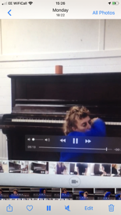
Screenshot from video of studio embodied piano work to donated songs
I eventually felt compelled to move with the piano, which gave me the opportunity to listen openly with my body, feeling the present moment alongside the memories and emotions carried within the music for me. I became lost in the moment, and watching the video back I could see that ways of being with the piano and the music had some similarities to previous embodied piano practice of mine. I found states of collapse, stillness and micro-movement just as I have with my previous embodied piano work and my work with dancer Rosamond Martin (Ways of Being). Each of these embodied practices is a collaboration, a dialogue, a duet. This work became an extension of this, allowing me to interpret the song choices of other artists with Middle Eastern cultural heritage, and to make connections to these translations in the present moment through improvisation.
Digital improvisation and dialogue
I filmed my embodied piano work and then recorded the playback of the video on my laptop with my iPhone whilst listening to the songs again loudly whilst improvising with the video, watching myself as I was moved emotionally and physically by the songs that were shared with me, and changing the movement again by skipping forwards and backwards, running video in reverse and joining different movements up to make a new choreographic score of sorts. You can see this practice here
Learning and next steps
I will now continue this work, listening with my body, connecting many more present moments, which I continue to believe is a way to bridge sometimes painful (dis) connections to cultural heritage. Through the process of creating a performance piece, as Zahra and Jumana stated, and through the performance itself. The borders of identity, of binary ways of being, are explored and given space through embodied practice. The next steps for me will be piecing together a choreographic score of piano work so that I can share it with other movement practitioners, and creating a piece of choral music which follows both the notes made by embodied piano work and the ways of being with the piano. I would like to create a small scale performance which includes these aspects and the improvised video work as well as live embodied piano work. I will of course include embodiment of my Arabic cultural heritage. I am truly excited to see what develops.
You can follow my studio work on Instagram: https://www.instagram.com/najiabagi/
And my commissions on my website: http://www.najiabagi.com/commissions.html
READINGS
- Frankowski, A, Being without time: Temporality and the white gaze, Educational Philosophy and Theory 50 (13):1285-1287 (2018)
- Yasemin Nuhoglu Soysal, “Citizenship and Identity: Living in Diasporas in Post-war Europe?” Ethnic and Racial Studies 23, no. 1 (2000): 1-15.
Najia Bagi. Exploring the spaces within us: longing, waiting, transition, pause, breathing, Najia is an artist and curator who has worked internationally to produce installation, film, participatory projects and more recently embodied sound and movement work which explores her cultural identity. Najia uses rituals, gatherings, repetition and movement to connect herself and other to the spaces she creates. She works using her own and others’ singing voices along with film, photography and the gathering of people, to create environments that enable us to explore our relationships with ourselves and one another. Najia has delivered projects at Modern Art Oxford, HOME, Tate Liverpool, South London Gallery, Manchester Art Gallery, Whitworth Art Gallery, FACT, Goldsmiths College, The Hepworth Wakefield and Yorkshire Sculpture Park. She also works in the Creative Learning team at Modern Art Oxford and has significant experience as a project manager and creative producer. www.najiabagi.com
Umama Hamido. Living on the border between many places and nowhere, Umama Hamido is a Lebanese artist who is currently in the UK. Through montages of performance, film, sound, and text she addresses experiences of loss, yearning, and remembrance. Her work unearths the ever-present human threads of resistance within seemingly insurmountable structures of power. @zarqalyamama
Zahra Haji Fath Ali Tehrani. As a solo artist Zahra Haji Fath Ali Tehrani works under the pseudonym Despicable Zee, creating wonky yet meditative lo-fi tunes, punctuated by biting rhythms. Working with her own vocal and lyrical content, she layers melancholy, lazy melodies to shape a sound that sits somewhere between poetry and quiet rap. The songs are steeped in issues relating to identity, heritage, relationships and change – they sound like echoes of something, partially forgotten. Zahra has been writing and performing for more than 15 years. As well as her own music Zahra is also the director of Oxford’s Young Women’s Music Project which is an educational charity that provides free workshops for women aged 14-21. www.zhfatehrani.com
Jumana Hokan is a Syrian/British multidisciplinary artist presently working in the UK. Her current practice involves creating varied interdisciplinary interventions that present narratives, which may question, challenge and explore the psychological and cultural impact of diasporas in communities and our fragile relationships between heritage, cultural and geographical identities, gender and societal evolution. www.jumanahokan.com
Featured image credits: Najia Bagi, Piano Work 2019. Photo credit: Andrew Bell